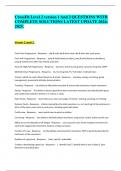CrossFit Level 2 version 1 And 2 QUESTIONS WITH
COMPLETE SOLUTIONS LATEST UPDATE 2024-
2025.
Verson 1 Level 2.
Push Press Progressions - Response - dip & hold, dip & drive slow, dip & drive fast, push press
Push Jerk Progressions - Response - jump & land (hands at sides), jump & land (hands at shoulders),
jump & extend arms after hips extend, push jerk
Sumo DL High Pull Progressions - Response - Sumo DL, Sumo DL shrug slow, sumo DL shrug fast, SDHP
Med Ball Clean Progressions - Response - DL, DL shrug fast, FS, Pull Under, med ball clean
Trainer's ability to coach others (based on 6 areas) - Response - teaching, seeing, correcting, group
management, presence & attitude, demonstration
Teaching - Response - the ability to effectively articulate & instruct the mechanics of each movement
Seeing - Response - The ability to discern good from poor movement mechanics and identify both gross
and subtle faults whether athlete is in motion or static
Static Faults - Response - faults that occur near end ranges of motion- starting, receiving, or finishing-
Dynamic Faults - Response - athlete moving btw the static positions- ex. not reaching full hip extension in
drive of the clean, push early in push press, initiating squat with knees
Profile view - Response - most useful view to watch an athlete
Correcting - Response - the ability to facilitate better mechanics using visual, verbal, and/or tactile cues
Ability to correct depends on (4 things) - Response - use successful cues, know multiple corrections for
each fault, triage faulty movement, balance critique w/ praise
Function of a cue - Response - to help athlete execute perfect mechanics, NOT to perfectly describe the
mechanics of the movement
Qualities of a good cue - Response - short, specific, actionable
3 steps to developing a good cue - Response - 1. identify fault 2. identify what is out of place 3. give
direction to that body part
, Verbal cue - Response - tell specific instruction
Visual cue - Response - create contrasting images btw current & desired positioning
Tactile cure - Response - use physical targets to achieve proper mechanics
Triaging faults - Response - assigning urgency to faults, ordering based on severity of deviation from
ideal & athlete's capacity relative to the task
Group management - Response - ability to organize and manage both at a micro level (class) and macro
level (gym); managing time well, organization of space, equipment and participants, adhere to schedule
etc.
Presence & attitude - Response - ability to create a positive and engaging learning environment
Demonstration - Response - the ability to provide athletes w/ an accurate visual example
Common movement themes for functional movements - Response - midline stabilization, core
to
extremity movement, balance about the frontal plane, posterior chain engagement, sound hip function,
active shoulders, full ROM about a joint, effective stance or grip
Midline - Response - relationship of the spine and pelvis during functional movement
midline stabilization - Response - athlete's capacity to prevent movement from this neutral spinal
position; synonymous w/ core strength
Creates midline stabilization - Response - engagement of abs, internal & external obliques, and spinal
errectors
Deviations from neutral spine - Response - Flexion, extension
Most risky deviation from neutral/ midline stabilization - Response - loss of neutral spine during
movement
Core to Extremity movements - Response - a sequence of muscular contraction beginning w/ large
force producing, low velocity muscles of the core and hips and ends w/ small force producing, high
velocity muscles of the extremities
Muscles more likely of injury - Response - smaller muscle groups and tendons/ligaments
Balance about the frontal plane - Response - athletes movements accommodate the object and may
or may not be characterized by straight lines; frontal plane divides athlete into anterior/posterior
halves (bisects athlete at mid foot
Posterior chain - Response - hamstrings, glutes, spinal errectors




